Managing Financial Resources and Decisions
VerifiedAdded on 2020/02/05
|18
|5335
|47
Report
AI Summary
This report examines the management of financial resources and decisions for Clariton Antiques Limited. It discusses various sources of finance, evaluates their impacts, and highlights the importance of financial planning. The report also includes a cash budget analysis, investment decisions, and a comparison of financial statements, providing a comprehensive overview of the financial management strategies employed by the company.

Managing Financial
Resources and Financial
Decisions
Resources and Financial
Decisions
Paraphrase This Document
Need a fresh take? Get an instant paraphrase of this document with our AI Paraphraser
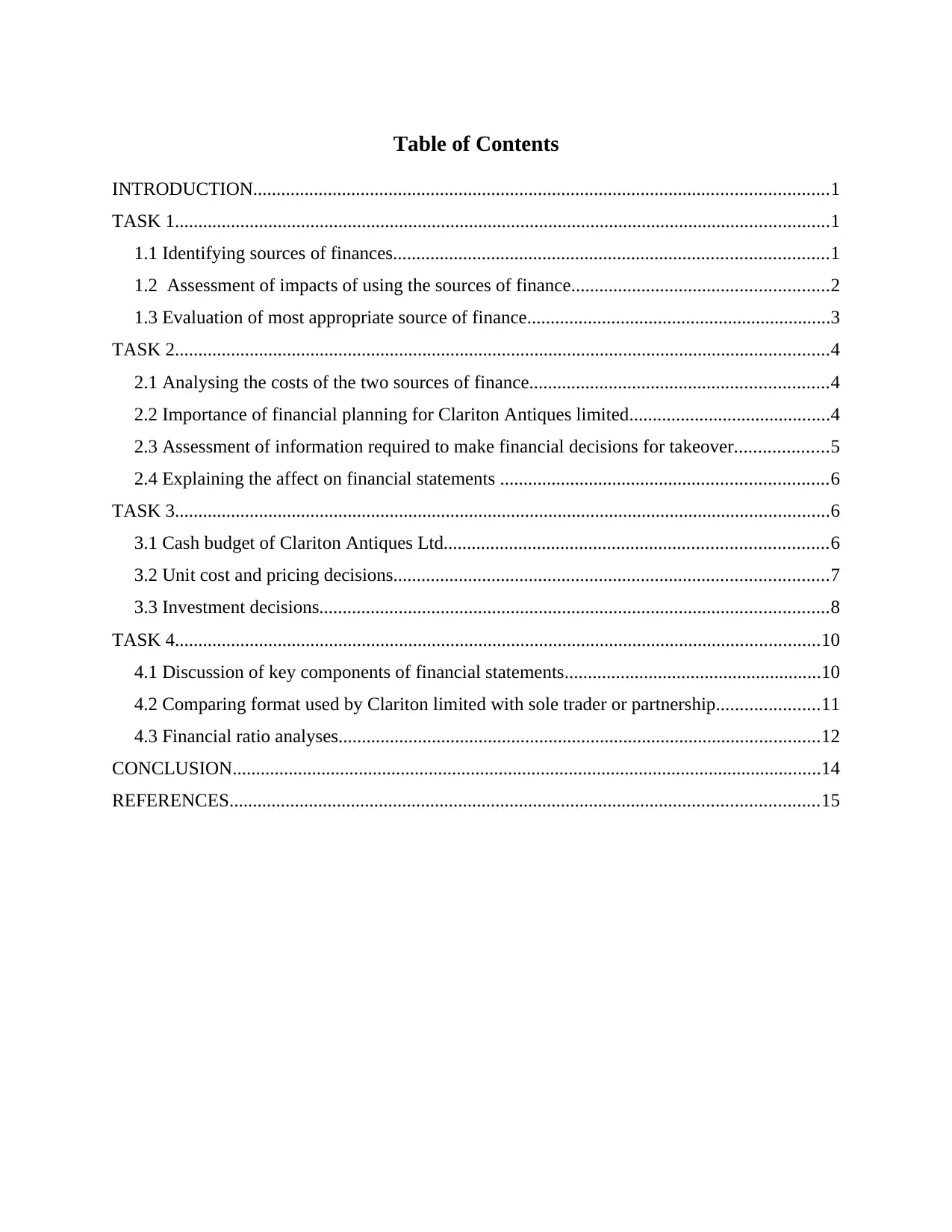
Table of Contents
INTRODUCTION...........................................................................................................................1
TASK 1............................................................................................................................................1
1.1 Identifying sources of finances.............................................................................................1
1.2 Assessment of impacts of using the sources of finance.......................................................2
1.3 Evaluation of most appropriate source of finance.................................................................3
TASK 2............................................................................................................................................4
2.1 Analysing the costs of the two sources of finance................................................................4
2.2 Importance of financial planning for Clariton Antiques limited...........................................4
2.3 Assessment of information required to make financial decisions for takeover....................5
2.4 Explaining the affect on financial statements ......................................................................6
TASK 3............................................................................................................................................6
3.1 Cash budget of Clariton Antiques Ltd..................................................................................6
3.2 Unit cost and pricing decisions.............................................................................................7
3.3 Investment decisions.............................................................................................................8
TASK 4..........................................................................................................................................10
4.1 Discussion of key components of financial statements.......................................................10
4.2 Comparing format used by Clariton limited with sole trader or partnership......................11
4.3 Financial ratio analyses.......................................................................................................12
CONCLUSION..............................................................................................................................14
REFERENCES..............................................................................................................................15
INTRODUCTION...........................................................................................................................1
TASK 1............................................................................................................................................1
1.1 Identifying sources of finances.............................................................................................1
1.2 Assessment of impacts of using the sources of finance.......................................................2
1.3 Evaluation of most appropriate source of finance.................................................................3
TASK 2............................................................................................................................................4
2.1 Analysing the costs of the two sources of finance................................................................4
2.2 Importance of financial planning for Clariton Antiques limited...........................................4
2.3 Assessment of information required to make financial decisions for takeover....................5
2.4 Explaining the affect on financial statements ......................................................................6
TASK 3............................................................................................................................................6
3.1 Cash budget of Clariton Antiques Ltd..................................................................................6
3.2 Unit cost and pricing decisions.............................................................................................7
3.3 Investment decisions.............................................................................................................8
TASK 4..........................................................................................................................................10
4.1 Discussion of key components of financial statements.......................................................10
4.2 Comparing format used by Clariton limited with sole trader or partnership......................11
4.3 Financial ratio analyses.......................................................................................................12
CONCLUSION..............................................................................................................................14
REFERENCES..............................................................................................................................15
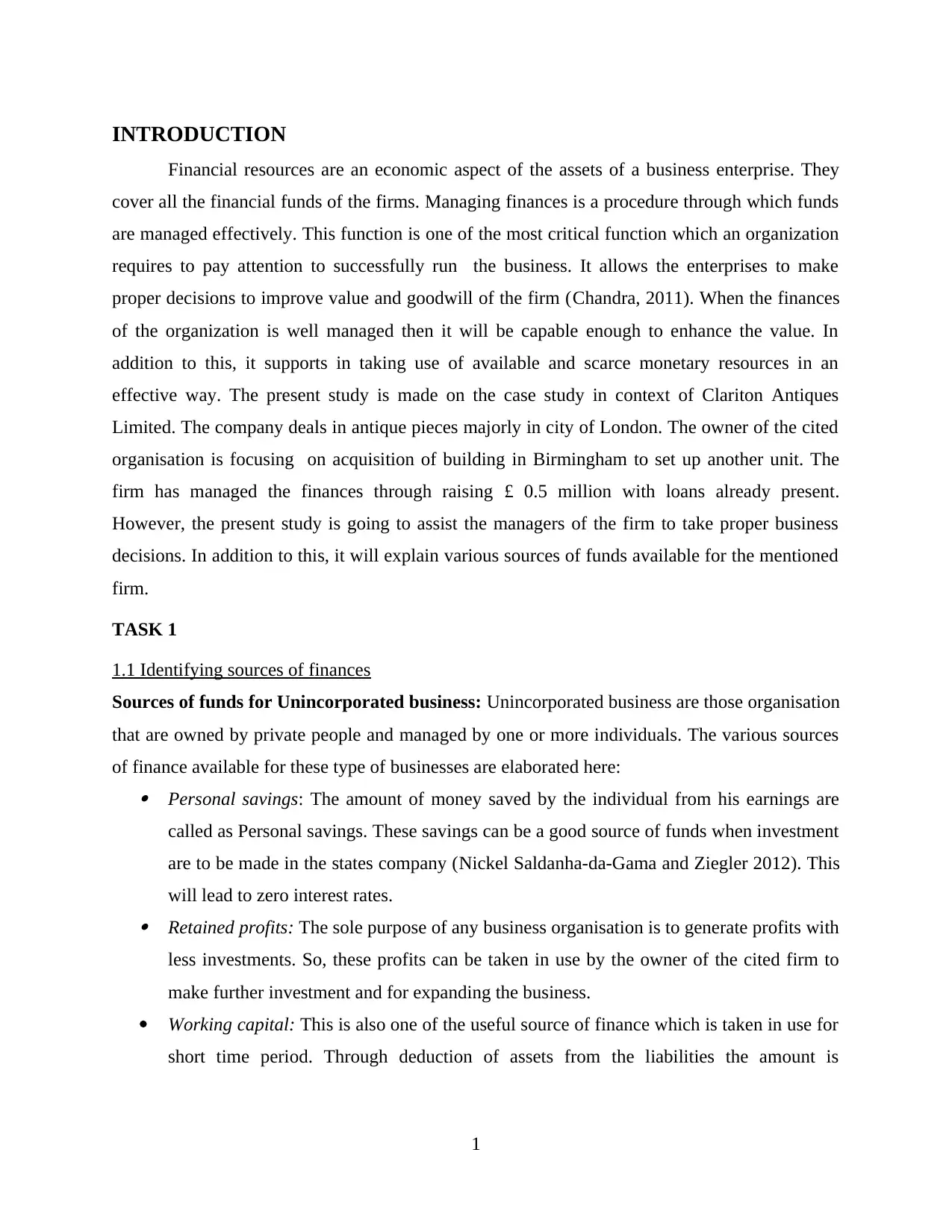
INTRODUCTION
Financial resources are an economic aspect of the assets of a business enterprise. They
cover all the financial funds of the firms. Managing finances is a procedure through which funds
are managed effectively. This function is one of the most critical function which an organization
requires to pay attention to successfully run the business. It allows the enterprises to make
proper decisions to improve value and goodwill of the firm (Chandra, 2011). When the finances
of the organization is well managed then it will be capable enough to enhance the value. In
addition to this, it supports in taking use of available and scarce monetary resources in an
effective way. The present study is made on the case study in context of Clariton Antiques
Limited. The company deals in antique pieces majorly in city of London. The owner of the cited
organisation is focusing on acquisition of building in Birmingham to set up another unit. The
firm has managed the finances through raising £ 0.5 million with loans already present.
However, the present study is going to assist the managers of the firm to take proper business
decisions. In addition to this, it will explain various sources of funds available for the mentioned
firm.
TASK 1
1.1 Identifying sources of finances
Sources of funds for Unincorporated business: Unincorporated business are those organisation
that are owned by private people and managed by one or more individuals. The various sources
of finance available for these type of businesses are elaborated here: Personal savings: The amount of money saved by the individual from his earnings are
called as Personal savings. These savings can be a good source of funds when investment
are to be made in the states company (Nickel Saldanha-da-Gama and Ziegler 2012). This
will lead to zero interest rates. Retained profits: The sole purpose of any business organisation is to generate profits with
less investments. So, these profits can be taken in use by the owner of the cited firm to
make further investment and for expanding the business.
Working capital: This is also one of the useful source of finance which is taken in use for
short time period. Through deduction of assets from the liabilities the amount is
1
Financial resources are an economic aspect of the assets of a business enterprise. They
cover all the financial funds of the firms. Managing finances is a procedure through which funds
are managed effectively. This function is one of the most critical function which an organization
requires to pay attention to successfully run the business. It allows the enterprises to make
proper decisions to improve value and goodwill of the firm (Chandra, 2011). When the finances
of the organization is well managed then it will be capable enough to enhance the value. In
addition to this, it supports in taking use of available and scarce monetary resources in an
effective way. The present study is made on the case study in context of Clariton Antiques
Limited. The company deals in antique pieces majorly in city of London. The owner of the cited
organisation is focusing on acquisition of building in Birmingham to set up another unit. The
firm has managed the finances through raising £ 0.5 million with loans already present.
However, the present study is going to assist the managers of the firm to take proper business
decisions. In addition to this, it will explain various sources of funds available for the mentioned
firm.
TASK 1
1.1 Identifying sources of finances
Sources of funds for Unincorporated business: Unincorporated business are those organisation
that are owned by private people and managed by one or more individuals. The various sources
of finance available for these type of businesses are elaborated here: Personal savings: The amount of money saved by the individual from his earnings are
called as Personal savings. These savings can be a good source of funds when investment
are to be made in the states company (Nickel Saldanha-da-Gama and Ziegler 2012). This
will lead to zero interest rates. Retained profits: The sole purpose of any business organisation is to generate profits with
less investments. So, these profits can be taken in use by the owner of the cited firm to
make further investment and for expanding the business.
Working capital: This is also one of the useful source of finance which is taken in use for
short time period. Through deduction of assets from the liabilities the amount is
1
⊘ This is a preview!⊘
Do you want full access?
Subscribe today to unlock all pages.

Trusted by 1+ million students worldwide
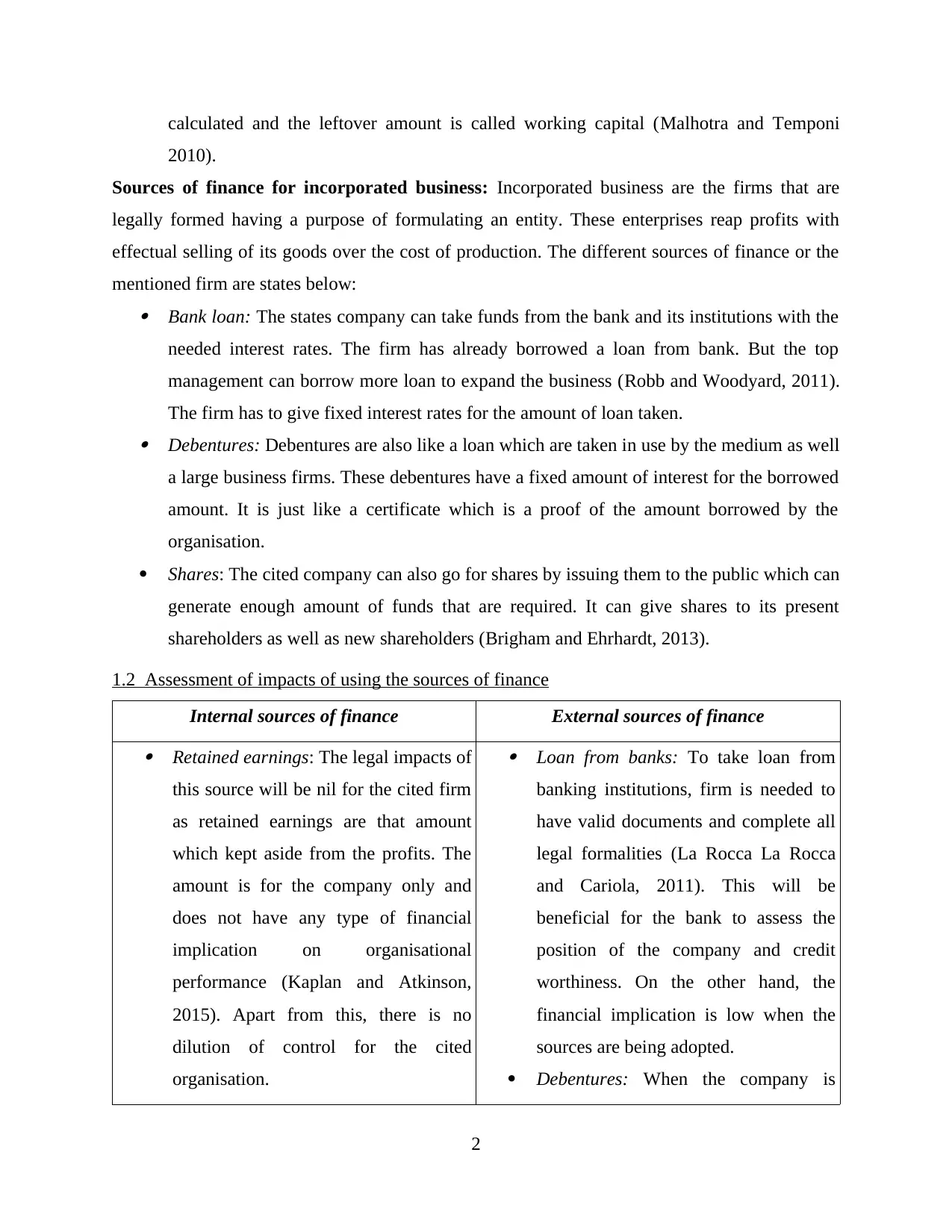
calculated and the leftover amount is called working capital (Malhotra and Temponi
2010).
Sources of finance for incorporated business: Incorporated business are the firms that are
legally formed having a purpose of formulating an entity. These enterprises reap profits with
effectual selling of its goods over the cost of production. The different sources of finance or the
mentioned firm are states below: Bank loan: The states company can take funds from the bank and its institutions with the
needed interest rates. The firm has already borrowed a loan from bank. But the top
management can borrow more loan to expand the business (Robb and Woodyard, 2011).
The firm has to give fixed interest rates for the amount of loan taken. Debentures: Debentures are also like a loan which are taken in use by the medium as well
a large business firms. These debentures have a fixed amount of interest for the borrowed
amount. It is just like a certificate which is a proof of the amount borrowed by the
organisation.
Shares: The cited company can also go for shares by issuing them to the public which can
generate enough amount of funds that are required. It can give shares to its present
shareholders as well as new shareholders (Brigham and Ehrhardt, 2013).
1.2 Assessment of impacts of using the sources of finance
Internal sources of finance External sources of finance Retained earnings: The legal impacts of
this source will be nil for the cited firm
as retained earnings are that amount
which kept aside from the profits. The
amount is for the company only and
does not have any type of financial
implication on organisational
performance (Kaplan and Atkinson,
2015). Apart from this, there is no
dilution of control for the cited
organisation.
Loan from banks: To take loan from
banking institutions, firm is needed to
have valid documents and complete all
legal formalities (La Rocca La Rocca
and Cariola, 2011). This will be
beneficial for the bank to assess the
position of the company and credit
worthiness. On the other hand, the
financial implication is low when the
sources are being adopted.
Debentures: When the company is
2
2010).
Sources of finance for incorporated business: Incorporated business are the firms that are
legally formed having a purpose of formulating an entity. These enterprises reap profits with
effectual selling of its goods over the cost of production. The different sources of finance or the
mentioned firm are states below: Bank loan: The states company can take funds from the bank and its institutions with the
needed interest rates. The firm has already borrowed a loan from bank. But the top
management can borrow more loan to expand the business (Robb and Woodyard, 2011).
The firm has to give fixed interest rates for the amount of loan taken. Debentures: Debentures are also like a loan which are taken in use by the medium as well
a large business firms. These debentures have a fixed amount of interest for the borrowed
amount. It is just like a certificate which is a proof of the amount borrowed by the
organisation.
Shares: The cited company can also go for shares by issuing them to the public which can
generate enough amount of funds that are required. It can give shares to its present
shareholders as well as new shareholders (Brigham and Ehrhardt, 2013).
1.2 Assessment of impacts of using the sources of finance
Internal sources of finance External sources of finance Retained earnings: The legal impacts of
this source will be nil for the cited firm
as retained earnings are that amount
which kept aside from the profits. The
amount is for the company only and
does not have any type of financial
implication on organisational
performance (Kaplan and Atkinson,
2015). Apart from this, there is no
dilution of control for the cited
organisation.
Loan from banks: To take loan from
banking institutions, firm is needed to
have valid documents and complete all
legal formalities (La Rocca La Rocca
and Cariola, 2011). This will be
beneficial for the bank to assess the
position of the company and credit
worthiness. On the other hand, the
financial implication is low when the
sources are being adopted.
Debentures: When the company is
2
Paraphrase This Document
Need a fresh take? Get an instant paraphrase of this document with our AI Paraphraser
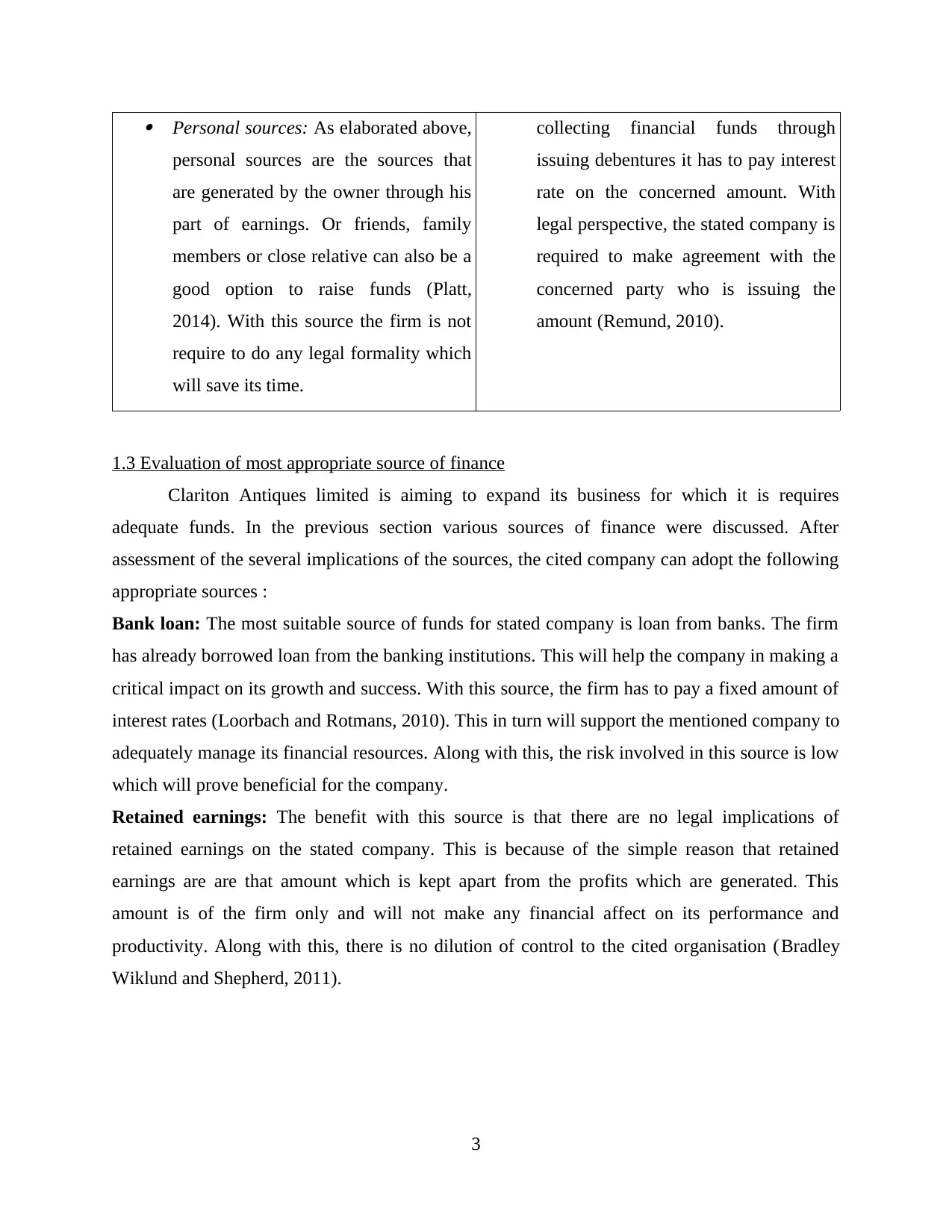
Personal sources: As elaborated above,
personal sources are the sources that
are generated by the owner through his
part of earnings. Or friends, family
members or close relative can also be a
good option to raise funds (Platt,
2014). With this source the firm is not
require to do any legal formality which
will save its time.
collecting financial funds through
issuing debentures it has to pay interest
rate on the concerned amount. With
legal perspective, the stated company is
required to make agreement with the
concerned party who is issuing the
amount (Remund, 2010).
1.3 Evaluation of most appropriate source of finance
Clariton Antiques limited is aiming to expand its business for which it is requires
adequate funds. In the previous section various sources of finance were discussed. After
assessment of the several implications of the sources, the cited company can adopt the following
appropriate sources :
Bank loan: The most suitable source of funds for stated company is loan from banks. The firm
has already borrowed loan from the banking institutions. This will help the company in making a
critical impact on its growth and success. With this source, the firm has to pay a fixed amount of
interest rates (Loorbach and Rotmans, 2010). This in turn will support the mentioned company to
adequately manage its financial resources. Along with this, the risk involved in this source is low
which will prove beneficial for the company.
Retained earnings: The benefit with this source is that there are no legal implications of
retained earnings on the stated company. This is because of the simple reason that retained
earnings are are that amount which is kept apart from the profits which are generated. This
amount is of the firm only and will not make any financial affect on its performance and
productivity. Along with this, there is no dilution of control to the cited organisation (Bradley
Wiklund and Shepherd, 2011).
3
personal sources are the sources that
are generated by the owner through his
part of earnings. Or friends, family
members or close relative can also be a
good option to raise funds (Platt,
2014). With this source the firm is not
require to do any legal formality which
will save its time.
collecting financial funds through
issuing debentures it has to pay interest
rate on the concerned amount. With
legal perspective, the stated company is
required to make agreement with the
concerned party who is issuing the
amount (Remund, 2010).
1.3 Evaluation of most appropriate source of finance
Clariton Antiques limited is aiming to expand its business for which it is requires
adequate funds. In the previous section various sources of finance were discussed. After
assessment of the several implications of the sources, the cited company can adopt the following
appropriate sources :
Bank loan: The most suitable source of funds for stated company is loan from banks. The firm
has already borrowed loan from the banking institutions. This will help the company in making a
critical impact on its growth and success. With this source, the firm has to pay a fixed amount of
interest rates (Loorbach and Rotmans, 2010). This in turn will support the mentioned company to
adequately manage its financial resources. Along with this, the risk involved in this source is low
which will prove beneficial for the company.
Retained earnings: The benefit with this source is that there are no legal implications of
retained earnings on the stated company. This is because of the simple reason that retained
earnings are are that amount which is kept apart from the profits which are generated. This
amount is of the firm only and will not make any financial affect on its performance and
productivity. Along with this, there is no dilution of control to the cited organisation (Bradley
Wiklund and Shepherd, 2011).
3
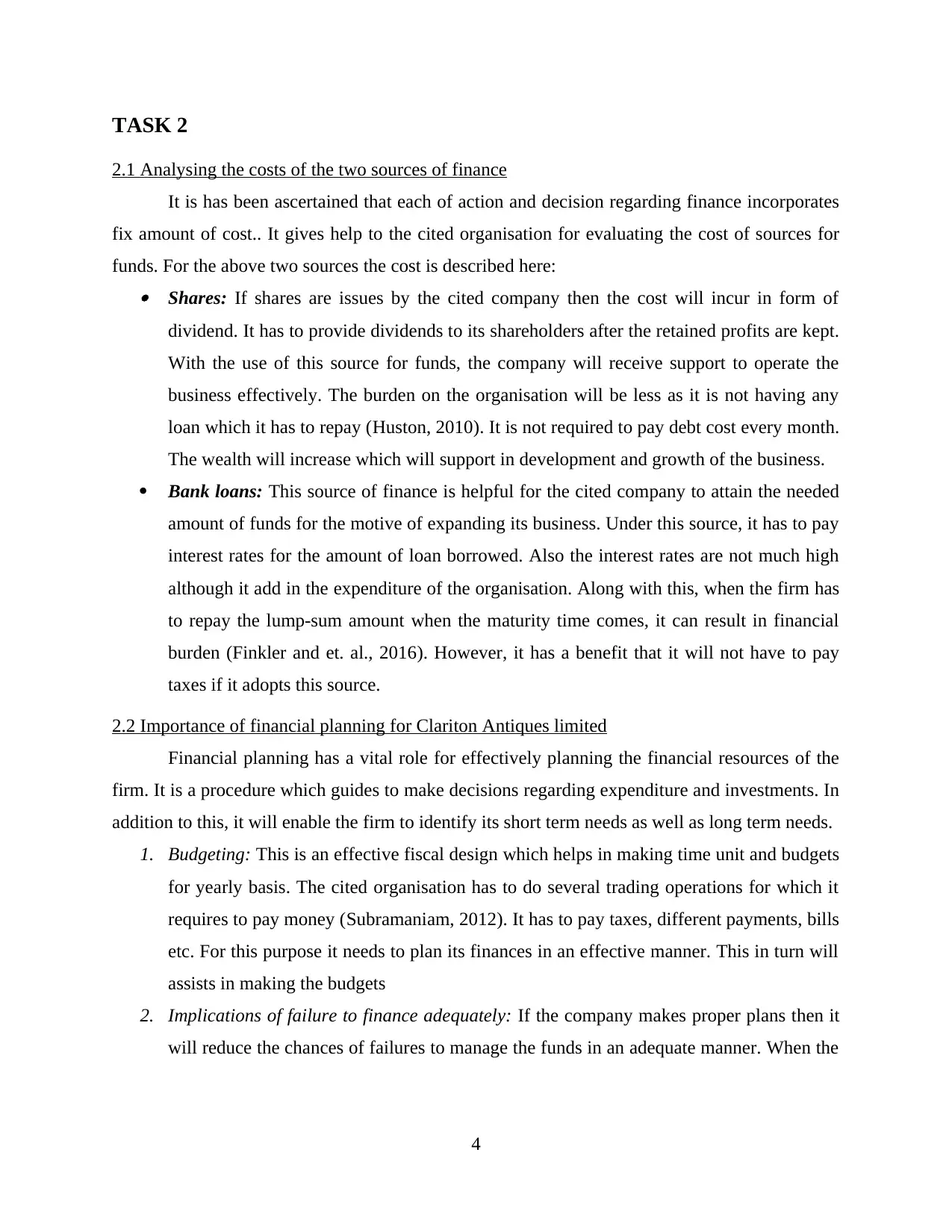
TASK 2
2.1 Analysing the costs of the two sources of finance
It is has been ascertained that each of action and decision regarding finance incorporates
fix amount of cost.. It gives help to the cited organisation for evaluating the cost of sources for
funds. For the above two sources the cost is described here: Shares: If shares are issues by the cited company then the cost will incur in form of
dividend. It has to provide dividends to its shareholders after the retained profits are kept.
With the use of this source for funds, the company will receive support to operate the
business effectively. The burden on the organisation will be less as it is not having any
loan which it has to repay (Huston, 2010). It is not required to pay debt cost every month.
The wealth will increase which will support in development and growth of the business.
Bank loans: This source of finance is helpful for the cited company to attain the needed
amount of funds for the motive of expanding its business. Under this source, it has to pay
interest rates for the amount of loan borrowed. Also the interest rates are not much high
although it add in the expenditure of the organisation. Along with this, when the firm has
to repay the lump-sum amount when the maturity time comes, it can result in financial
burden (Finkler and et. al., 2016). However, it has a benefit that it will not have to pay
taxes if it adopts this source.
2.2 Importance of financial planning for Clariton Antiques limited
Financial planning has a vital role for effectively planning the financial resources of the
firm. It is a procedure which guides to make decisions regarding expenditure and investments. In
addition to this, it will enable the firm to identify its short term needs as well as long term needs.
1. Budgeting: This is an effective fiscal design which helps in making time unit and budgets
for yearly basis. The cited organisation has to do several trading operations for which it
requires to pay money (Subramaniam, 2012). It has to pay taxes, different payments, bills
etc. For this purpose it needs to plan its finances in an effective manner. This in turn will
assists in making the budgets
2. Implications of failure to finance adequately: If the company makes proper plans then it
will reduce the chances of failures to manage the funds in an adequate manner. When the
4
2.1 Analysing the costs of the two sources of finance
It is has been ascertained that each of action and decision regarding finance incorporates
fix amount of cost.. It gives help to the cited organisation for evaluating the cost of sources for
funds. For the above two sources the cost is described here: Shares: If shares are issues by the cited company then the cost will incur in form of
dividend. It has to provide dividends to its shareholders after the retained profits are kept.
With the use of this source for funds, the company will receive support to operate the
business effectively. The burden on the organisation will be less as it is not having any
loan which it has to repay (Huston, 2010). It is not required to pay debt cost every month.
The wealth will increase which will support in development and growth of the business.
Bank loans: This source of finance is helpful for the cited company to attain the needed
amount of funds for the motive of expanding its business. Under this source, it has to pay
interest rates for the amount of loan borrowed. Also the interest rates are not much high
although it add in the expenditure of the organisation. Along with this, when the firm has
to repay the lump-sum amount when the maturity time comes, it can result in financial
burden (Finkler and et. al., 2016). However, it has a benefit that it will not have to pay
taxes if it adopts this source.
2.2 Importance of financial planning for Clariton Antiques limited
Financial planning has a vital role for effectively planning the financial resources of the
firm. It is a procedure which guides to make decisions regarding expenditure and investments. In
addition to this, it will enable the firm to identify its short term needs as well as long term needs.
1. Budgeting: This is an effective fiscal design which helps in making time unit and budgets
for yearly basis. The cited organisation has to do several trading operations for which it
requires to pay money (Subramaniam, 2012). It has to pay taxes, different payments, bills
etc. For this purpose it needs to plan its finances in an effective manner. This in turn will
assists in making the budgets
2. Implications of failure to finance adequately: If the company makes proper plans then it
will reduce the chances of failures to manage the funds in an adequate manner. When the
4
⊘ This is a preview!⊘
Do you want full access?
Subscribe today to unlock all pages.

Trusted by 1+ million students worldwide
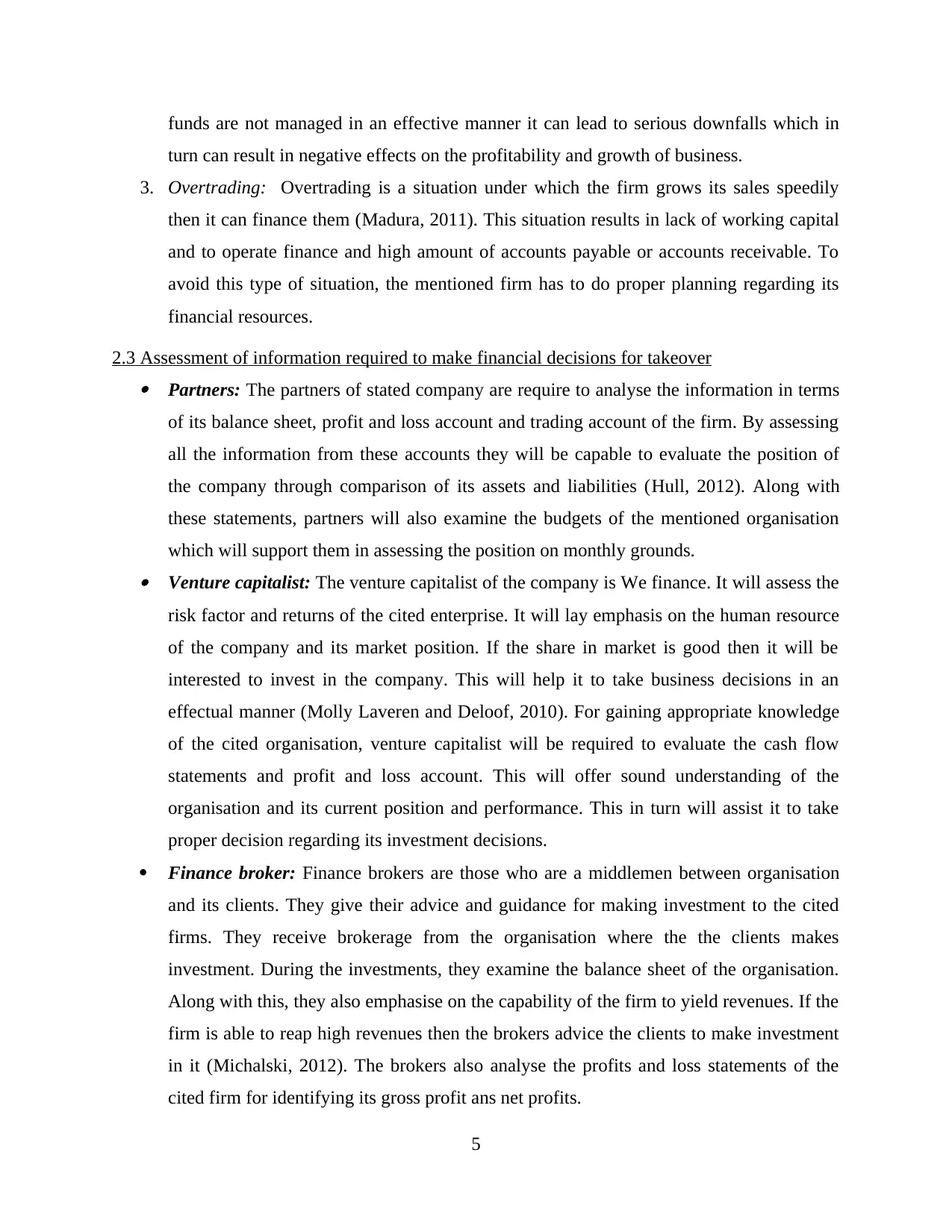
funds are not managed in an effective manner it can lead to serious downfalls which in
turn can result in negative effects on the profitability and growth of business.
3. Overtrading: Overtrading is a situation under which the firm grows its sales speedily
then it can finance them (Madura, 2011). This situation results in lack of working capital
and to operate finance and high amount of accounts payable or accounts receivable. To
avoid this type of situation, the mentioned firm has to do proper planning regarding its
financial resources.
2.3 Assessment of information required to make financial decisions for takeover Partners: The partners of stated company are require to analyse the information in terms
of its balance sheet, profit and loss account and trading account of the firm. By assessing
all the information from these accounts they will be capable to evaluate the position of
the company through comparison of its assets and liabilities (Hull, 2012). Along with
these statements, partners will also examine the budgets of the mentioned organisation
which will support them in assessing the position on monthly grounds. Venture capitalist: The venture capitalist of the company is We finance. It will assess the
risk factor and returns of the cited enterprise. It will lay emphasis on the human resource
of the company and its market position. If the share in market is good then it will be
interested to invest in the company. This will help it to take business decisions in an
effectual manner (Molly Laveren and Deloof, 2010). For gaining appropriate knowledge
of the cited organisation, venture capitalist will be required to evaluate the cash flow
statements and profit and loss account. This will offer sound understanding of the
organisation and its current position and performance. This in turn will assist it to take
proper decision regarding its investment decisions.
Finance broker: Finance brokers are those who are a middlemen between organisation
and its clients. They give their advice and guidance for making investment to the cited
firms. They receive brokerage from the organisation where the the clients makes
investment. During the investments, they examine the balance sheet of the organisation.
Along with this, they also emphasise on the capability of the firm to yield revenues. If the
firm is able to reap high revenues then the brokers advice the clients to make investment
in it (Michalski, 2012). The brokers also analyse the profits and loss statements of the
cited firm for identifying its gross profit ans net profits.
5
turn can result in negative effects on the profitability and growth of business.
3. Overtrading: Overtrading is a situation under which the firm grows its sales speedily
then it can finance them (Madura, 2011). This situation results in lack of working capital
and to operate finance and high amount of accounts payable or accounts receivable. To
avoid this type of situation, the mentioned firm has to do proper planning regarding its
financial resources.
2.3 Assessment of information required to make financial decisions for takeover Partners: The partners of stated company are require to analyse the information in terms
of its balance sheet, profit and loss account and trading account of the firm. By assessing
all the information from these accounts they will be capable to evaluate the position of
the company through comparison of its assets and liabilities (Hull, 2012). Along with
these statements, partners will also examine the budgets of the mentioned organisation
which will support them in assessing the position on monthly grounds. Venture capitalist: The venture capitalist of the company is We finance. It will assess the
risk factor and returns of the cited enterprise. It will lay emphasis on the human resource
of the company and its market position. If the share in market is good then it will be
interested to invest in the company. This will help it to take business decisions in an
effectual manner (Molly Laveren and Deloof, 2010). For gaining appropriate knowledge
of the cited organisation, venture capitalist will be required to evaluate the cash flow
statements and profit and loss account. This will offer sound understanding of the
organisation and its current position and performance. This in turn will assist it to take
proper decision regarding its investment decisions.
Finance broker: Finance brokers are those who are a middlemen between organisation
and its clients. They give their advice and guidance for making investment to the cited
firms. They receive brokerage from the organisation where the the clients makes
investment. During the investments, they examine the balance sheet of the organisation.
Along with this, they also emphasise on the capability of the firm to yield revenues. If the
firm is able to reap high revenues then the brokers advice the clients to make investment
in it (Michalski, 2012). The brokers also analyse the profits and loss statements of the
cited firm for identifying its gross profit ans net profits.
5
Paraphrase This Document
Need a fresh take? Get an instant paraphrase of this document with our AI Paraphraser
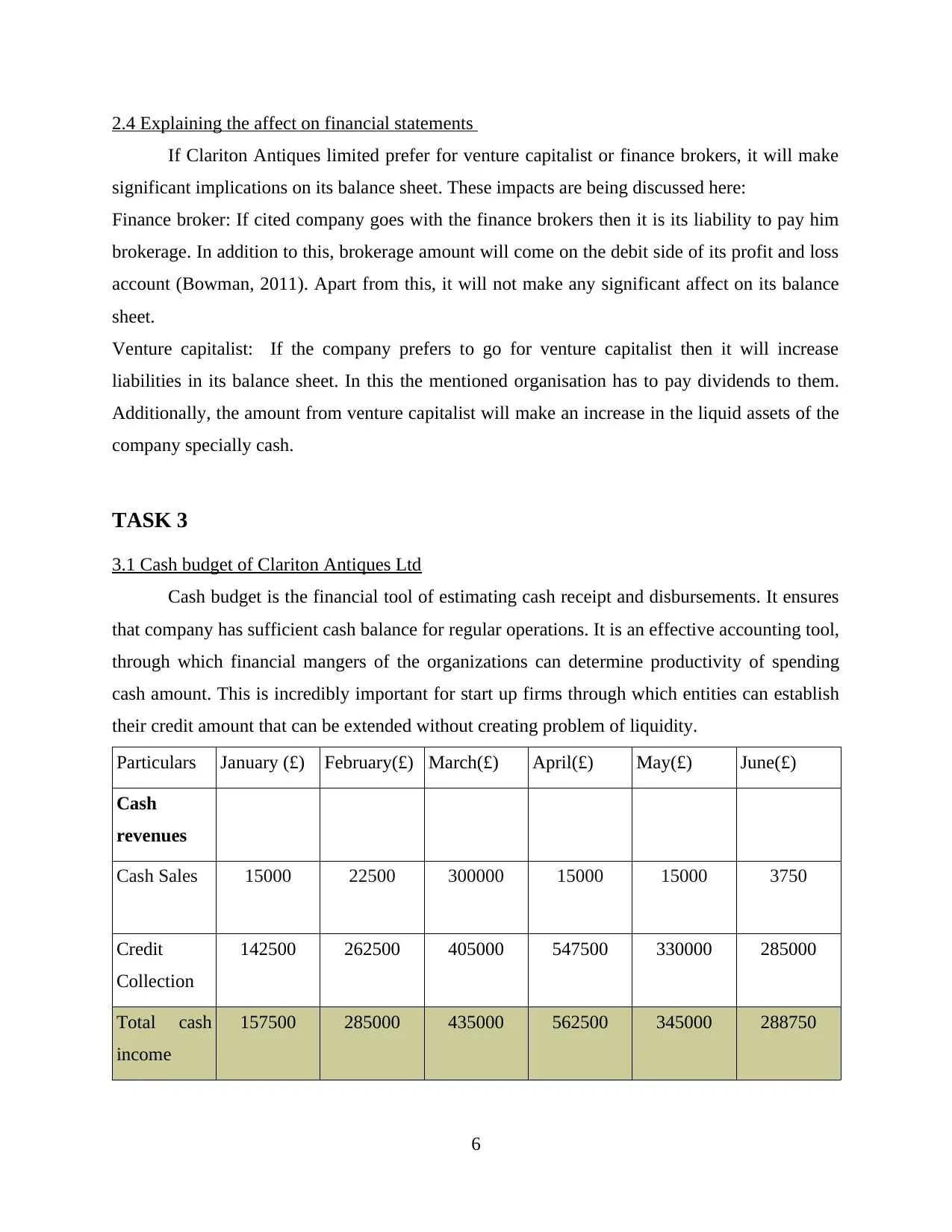
2.4 Explaining the affect on financial statements
If Clariton Antiques limited prefer for venture capitalist or finance brokers, it will make
significant implications on its balance sheet. These impacts are being discussed here:
Finance broker: If cited company goes with the finance brokers then it is its liability to pay him
brokerage. In addition to this, brokerage amount will come on the debit side of its profit and loss
account (Bowman, 2011). Apart from this, it will not make any significant affect on its balance
sheet.
Venture capitalist: If the company prefers to go for venture capitalist then it will increase
liabilities in its balance sheet. In this the mentioned organisation has to pay dividends to them.
Additionally, the amount from venture capitalist will make an increase in the liquid assets of the
company specially cash.
TASK 3
3.1 Cash budget of Clariton Antiques Ltd
Cash budget is the financial tool of estimating cash receipt and disbursements. It ensures
that company has sufficient cash balance for regular operations. It is an effective accounting tool,
through which financial mangers of the organizations can determine productivity of spending
cash amount. This is incredibly important for start up firms through which entities can establish
their credit amount that can be extended without creating problem of liquidity.
Particulars January (£) February(£) March(£) April(£) May(£) June(£)
Cash
revenues
Cash Sales 15000 22500 300000 15000 15000 3750
Credit
Collection
142500 262500 405000 547500 330000 285000
Total cash
income
157500 285000 435000 562500 345000 288750
6
If Clariton Antiques limited prefer for venture capitalist or finance brokers, it will make
significant implications on its balance sheet. These impacts are being discussed here:
Finance broker: If cited company goes with the finance brokers then it is its liability to pay him
brokerage. In addition to this, brokerage amount will come on the debit side of its profit and loss
account (Bowman, 2011). Apart from this, it will not make any significant affect on its balance
sheet.
Venture capitalist: If the company prefers to go for venture capitalist then it will increase
liabilities in its balance sheet. In this the mentioned organisation has to pay dividends to them.
Additionally, the amount from venture capitalist will make an increase in the liquid assets of the
company specially cash.
TASK 3
3.1 Cash budget of Clariton Antiques Ltd
Cash budget is the financial tool of estimating cash receipt and disbursements. It ensures
that company has sufficient cash balance for regular operations. It is an effective accounting tool,
through which financial mangers of the organizations can determine productivity of spending
cash amount. This is incredibly important for start up firms through which entities can establish
their credit amount that can be extended without creating problem of liquidity.
Particulars January (£) February(£) March(£) April(£) May(£) June(£)
Cash
revenues
Cash Sales 15000 22500 300000 15000 15000 3750
Credit
Collection
142500 262500 405000 547500 330000 285000
Total cash
income
157500 285000 435000 562500 345000 288750
6
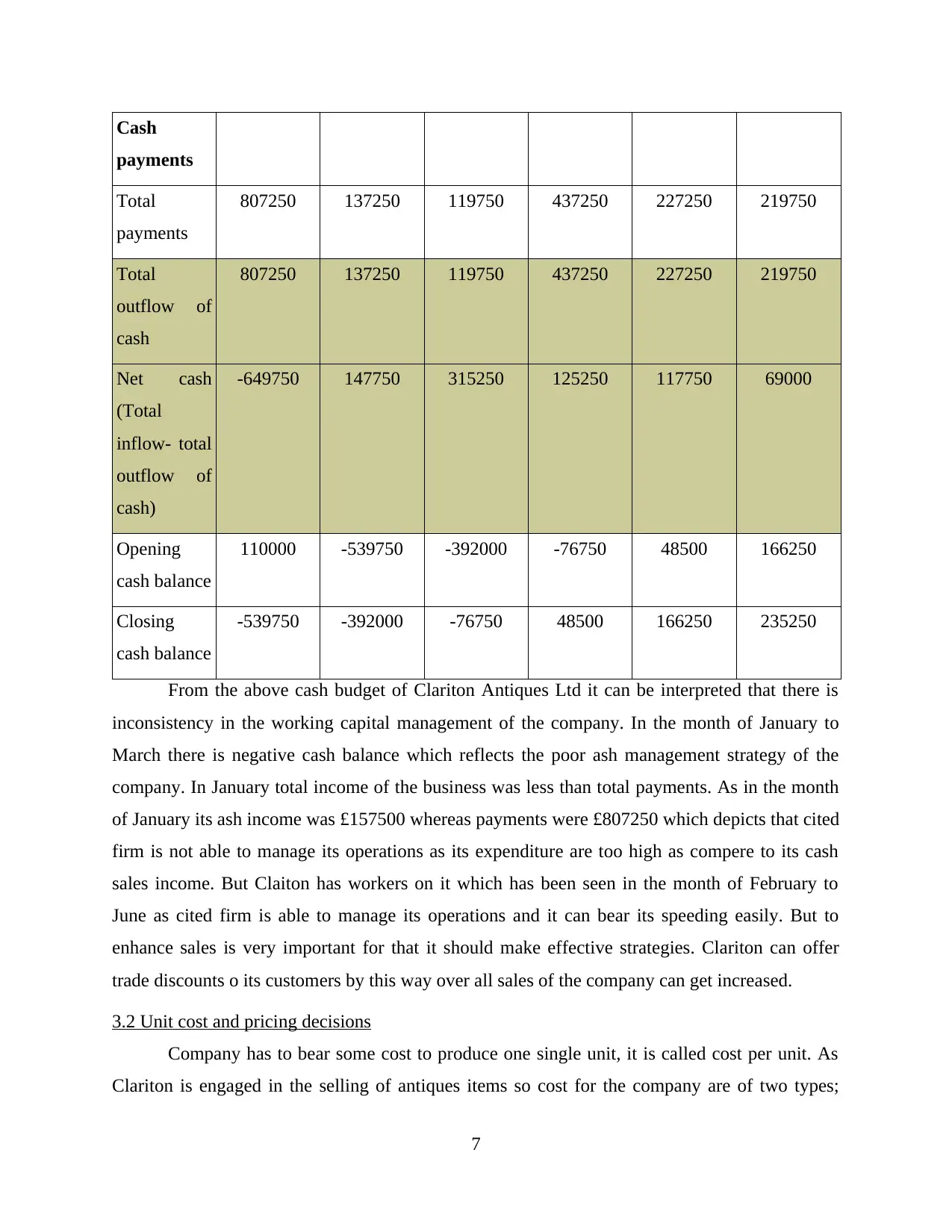
Cash
payments
Total
payments
807250 137250 119750 437250 227250 219750
Total
outflow of
cash
807250 137250 119750 437250 227250 219750
Net cash
(Total
inflow- total
outflow of
cash)
-649750 147750 315250 125250 117750 69000
Opening
cash balance
110000 -539750 -392000 -76750 48500 166250
Closing
cash balance
-539750 -392000 -76750 48500 166250 235250
From the above cash budget of Clariton Antiques Ltd it can be interpreted that there is
inconsistency in the working capital management of the company. In the month of January to
March there is negative cash balance which reflects the poor ash management strategy of the
company. In January total income of the business was less than total payments. As in the month
of January its ash income was £157500 whereas payments were £807250 which depicts that cited
firm is not able to manage its operations as its expenditure are too high as compere to its cash
sales income. But Claiton has workers on it which has been seen in the month of February to
June as cited firm is able to manage its operations and it can bear its speeding easily. But to
enhance sales is very important for that it should make effective strategies. Clariton can offer
trade discounts o its customers by this way over all sales of the company can get increased.
3.2 Unit cost and pricing decisions
Company has to bear some cost to produce one single unit, it is called cost per unit. As
Clariton is engaged in the selling of antiques items so cost for the company are of two types;
7
payments
Total
payments
807250 137250 119750 437250 227250 219750
Total
outflow of
cash
807250 137250 119750 437250 227250 219750
Net cash
(Total
inflow- total
outflow of
cash)
-649750 147750 315250 125250 117750 69000
Opening
cash balance
110000 -539750 -392000 -76750 48500 166250
Closing
cash balance
-539750 -392000 -76750 48500 166250 235250
From the above cash budget of Clariton Antiques Ltd it can be interpreted that there is
inconsistency in the working capital management of the company. In the month of January to
March there is negative cash balance which reflects the poor ash management strategy of the
company. In January total income of the business was less than total payments. As in the month
of January its ash income was £157500 whereas payments were £807250 which depicts that cited
firm is not able to manage its operations as its expenditure are too high as compere to its cash
sales income. But Claiton has workers on it which has been seen in the month of February to
June as cited firm is able to manage its operations and it can bear its speeding easily. But to
enhance sales is very important for that it should make effective strategies. Clariton can offer
trade discounts o its customers by this way over all sales of the company can get increased.
3.2 Unit cost and pricing decisions
Company has to bear some cost to produce one single unit, it is called cost per unit. As
Clariton is engaged in the selling of antiques items so cost for the company are of two types;
7
⊘ This is a preview!⊘
Do you want full access?
Subscribe today to unlock all pages.

Trusted by 1+ million students worldwide
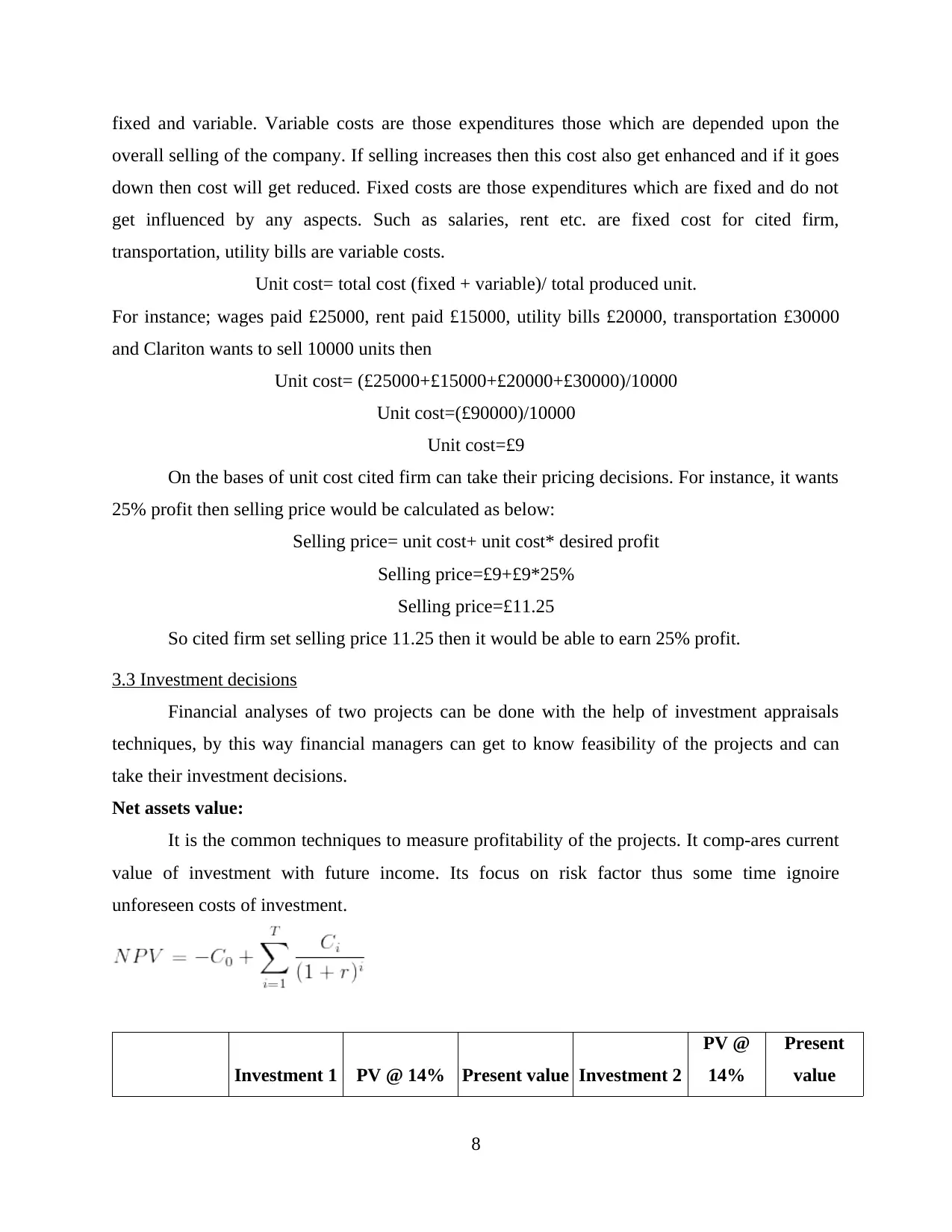
fixed and variable. Variable costs are those expenditures those which are depended upon the
overall selling of the company. If selling increases then this cost also get enhanced and if it goes
down then cost will get reduced. Fixed costs are those expenditures which are fixed and do not
get influenced by any aspects. Such as salaries, rent etc. are fixed cost for cited firm,
transportation, utility bills are variable costs.
Unit cost= total cost (fixed + variable)/ total produced unit.
For instance; wages paid £25000, rent paid £15000, utility bills £20000, transportation £30000
and Clariton wants to sell 10000 units then
Unit cost= (£25000+£15000+£20000+£30000)/10000
Unit cost=(£90000)/10000
Unit cost=£9
On the bases of unit cost cited firm can take their pricing decisions. For instance, it wants
25% profit then selling price would be calculated as below:
Selling price= unit cost+ unit cost* desired profit
Selling price=£9+£9*25%
Selling price=£11.25
So cited firm set selling price 11.25 then it would be able to earn 25% profit.
3.3 Investment decisions
Financial analyses of two projects can be done with the help of investment appraisals
techniques, by this way financial managers can get to know feasibility of the projects and can
take their investment decisions.
Net assets value:
It is the common techniques to measure profitability of the projects. It comp-ares current
value of investment with future income. Its focus on risk factor thus some time ignoire
unforeseen costs of investment.
Investment 1 PV @ 14% Present value Investment 2
PV @
14%
Present
value
8
overall selling of the company. If selling increases then this cost also get enhanced and if it goes
down then cost will get reduced. Fixed costs are those expenditures which are fixed and do not
get influenced by any aspects. Such as salaries, rent etc. are fixed cost for cited firm,
transportation, utility bills are variable costs.
Unit cost= total cost (fixed + variable)/ total produced unit.
For instance; wages paid £25000, rent paid £15000, utility bills £20000, transportation £30000
and Clariton wants to sell 10000 units then
Unit cost= (£25000+£15000+£20000+£30000)/10000
Unit cost=(£90000)/10000
Unit cost=£9
On the bases of unit cost cited firm can take their pricing decisions. For instance, it wants
25% profit then selling price would be calculated as below:
Selling price= unit cost+ unit cost* desired profit
Selling price=£9+£9*25%
Selling price=£11.25
So cited firm set selling price 11.25 then it would be able to earn 25% profit.
3.3 Investment decisions
Financial analyses of two projects can be done with the help of investment appraisals
techniques, by this way financial managers can get to know feasibility of the projects and can
take their investment decisions.
Net assets value:
It is the common techniques to measure profitability of the projects. It comp-ares current
value of investment with future income. Its focus on risk factor thus some time ignoire
unforeseen costs of investment.
Investment 1 PV @ 14% Present value Investment 2
PV @
14%
Present
value
8
Paraphrase This Document
Need a fresh take? Get an instant paraphrase of this document with our AI Paraphraser
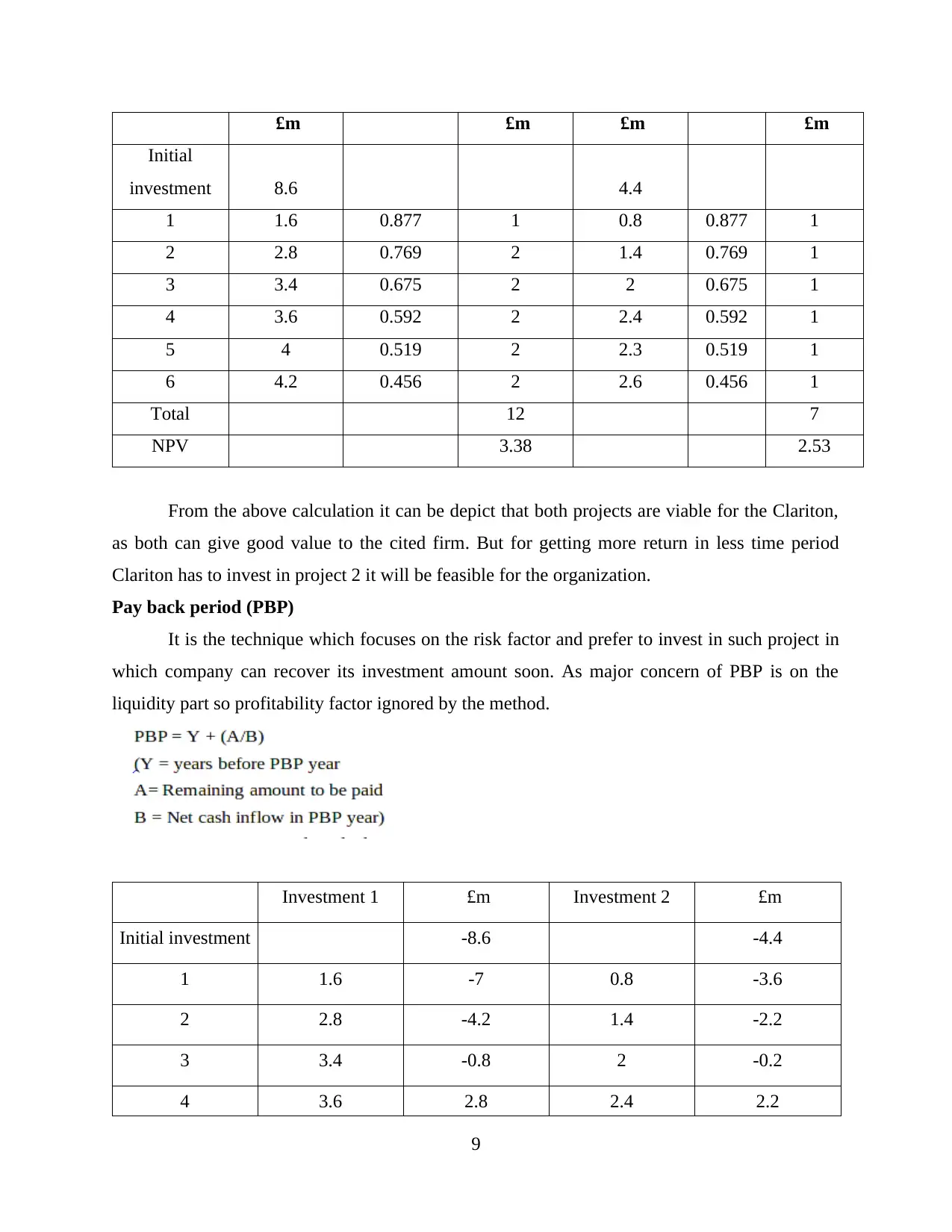
£m £m £m £m
Initial
investment 8.6 4.4
1 1.6 0.877 1 0.8 0.877 1
2 2.8 0.769 2 1.4 0.769 1
3 3.4 0.675 2 2 0.675 1
4 3.6 0.592 2 2.4 0.592 1
5 4 0.519 2 2.3 0.519 1
6 4.2 0.456 2 2.6 0.456 1
Total 12 7
NPV 3.38 2.53
From the above calculation it can be depict that both projects are viable for the Clariton,
as both can give good value to the cited firm. But for getting more return in less time period
Clariton has to invest in project 2 it will be feasible for the organization.
Pay back period (PBP)
It is the technique which focuses on the risk factor and prefer to invest in such project in
which company can recover its investment amount soon. As major concern of PBP is on the
liquidity part so profitability factor ignored by the method.
Investment 1 £m Investment 2 £m
Initial investment -8.6 -4.4
1 1.6 -7 0.8 -3.6
2 2.8 -4.2 1.4 -2.2
3 3.4 -0.8 2 -0.2
4 3.6 2.8 2.4 2.2
9
Initial
investment 8.6 4.4
1 1.6 0.877 1 0.8 0.877 1
2 2.8 0.769 2 1.4 0.769 1
3 3.4 0.675 2 2 0.675 1
4 3.6 0.592 2 2.4 0.592 1
5 4 0.519 2 2.3 0.519 1
6 4.2 0.456 2 2.6 0.456 1
Total 12 7
NPV 3.38 2.53
From the above calculation it can be depict that both projects are viable for the Clariton,
as both can give good value to the cited firm. But for getting more return in less time period
Clariton has to invest in project 2 it will be feasible for the organization.
Pay back period (PBP)
It is the technique which focuses on the risk factor and prefer to invest in such project in
which company can recover its investment amount soon. As major concern of PBP is on the
liquidity part so profitability factor ignored by the method.
Investment 1 £m Investment 2 £m
Initial investment -8.6 -4.4
1 1.6 -7 0.8 -3.6
2 2.8 -4.2 1.4 -2.2
3 3.4 -0.8 2 -0.2
4 3.6 2.8 2.4 2.2
9
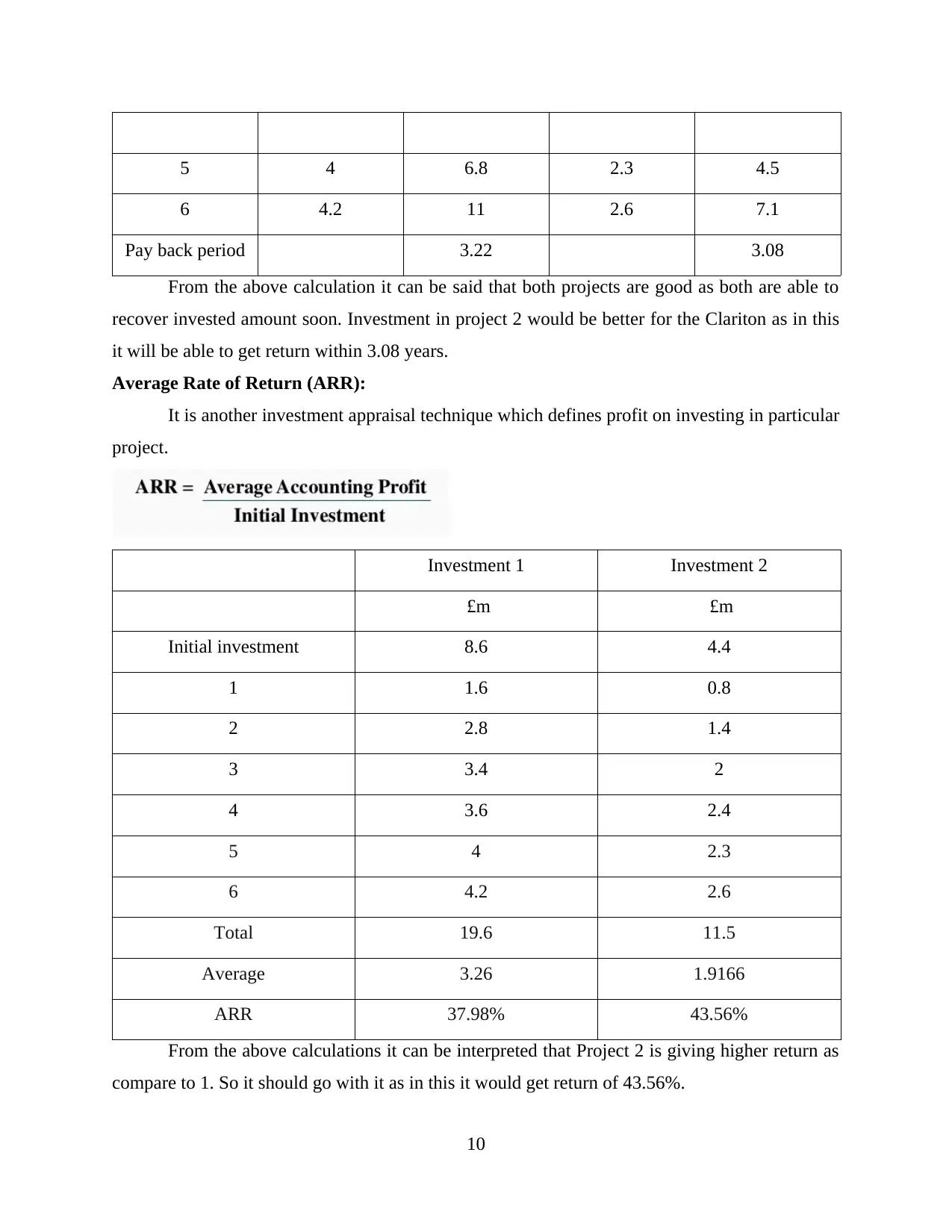
5 4 6.8 2.3 4.5
6 4.2 11 2.6 7.1
Pay back period 3.22 3.08
From the above calculation it can be said that both projects are good as both are able to
recover invested amount soon. Investment in project 2 would be better for the Clariton as in this
it will be able to get return within 3.08 years.
Average Rate of Return (ARR):
It is another investment appraisal technique which defines profit on investing in particular
project.
Investment 1 Investment 2
£m £m
Initial investment 8.6 4.4
1 1.6 0.8
2 2.8 1.4
3 3.4 2
4 3.6 2.4
5 4 2.3
6 4.2 2.6
Total 19.6 11.5
Average 3.26 1.9166
ARR 37.98% 43.56%
From the above calculations it can be interpreted that Project 2 is giving higher return as
compare to 1. So it should go with it as in this it would get return of 43.56%.
10
6 4.2 11 2.6 7.1
Pay back period 3.22 3.08
From the above calculation it can be said that both projects are good as both are able to
recover invested amount soon. Investment in project 2 would be better for the Clariton as in this
it will be able to get return within 3.08 years.
Average Rate of Return (ARR):
It is another investment appraisal technique which defines profit on investing in particular
project.
Investment 1 Investment 2
£m £m
Initial investment 8.6 4.4
1 1.6 0.8
2 2.8 1.4
3 3.4 2
4 3.6 2.4
5 4 2.3
6 4.2 2.6
Total 19.6 11.5
Average 3.26 1.9166
ARR 37.98% 43.56%
From the above calculations it can be interpreted that Project 2 is giving higher return as
compare to 1. So it should go with it as in this it would get return of 43.56%.
10
⊘ This is a preview!⊘
Do you want full access?
Subscribe today to unlock all pages.

Trusted by 1+ million students worldwide
1 out of 18
Related Documents
Your All-in-One AI-Powered Toolkit for Academic Success.
+13062052269
info@desklib.com
Available 24*7 on WhatsApp / Email
![[object Object]](/_next/static/media/star-bottom.7253800d.svg)
Unlock your academic potential
Copyright © 2020–2025 A2Z Services. All Rights Reserved. Developed and managed by ZUCOL.





